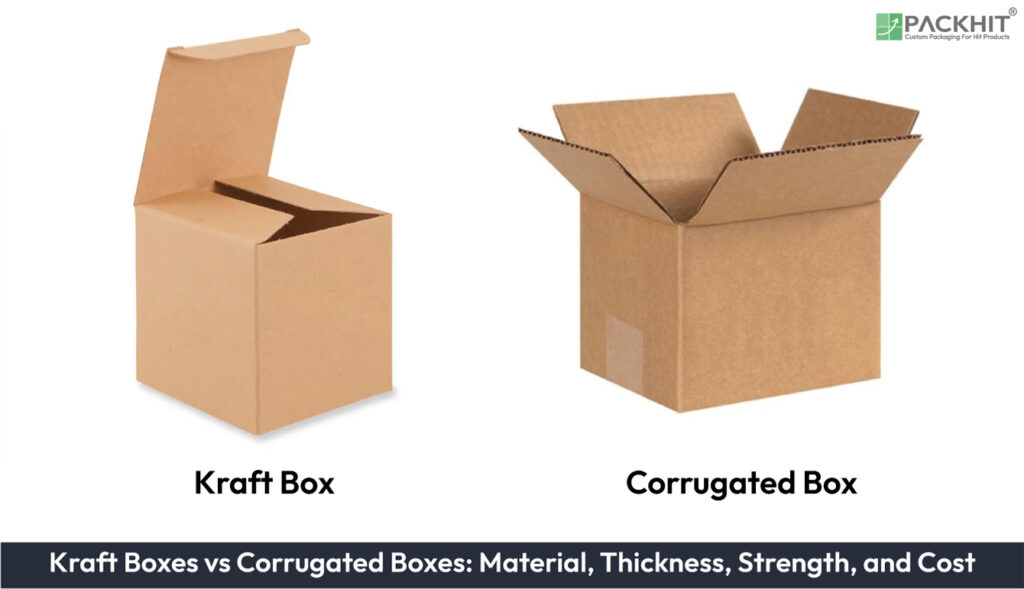Kraft boxes and corrugated boxes represent two distinct categories of paper-based packaging solutions, each optimized for specific applications based on their material composition, structural properties, and cost-effectiveness. Kraft boxes are made from kraft paper, derived from softwood fibers like pine or spruce, offering a lightweight yet robust packaging solution ideal for eco-friendly and cost-effective applications. Their single-layer construction provides moderate strength, suitable for lightweight retail items, though they can be reinforced with corrugated layers for added durability. In contrast, corrugated boxes feature multi-layered cardboard with fluted layers that enhance strength and load-bearing capacity, making them suitable for heavy-duty applications like shipping electronics and industrial goods. While kraft boxes are affordable and environmentally friendly, corrugated boxes offer superior protection but come at a higher cost. Both packaging types are recyclable, with kraft boxes being particularly praised for their sustainability.
What is the Difference Between Kraft Boxes and Corrugated Boxes?
Kraft boxes and corrugated boxes differ in several critical aspects, including material composition, structural design, thickness and size, strength and load capacity, cost, and environmental impact and suitability. Understanding these differences helps manufacturers select the most appropriate packaging solution for their specific needs.
The five key differences between kraft boxes and corrugated boxes are detailed below:
1. Material and Structure
Kraft boxes are constructed from kraft paper, a material derived from the chemical pulping process of softwood fibers such as pine or spruce. This process yields a high-strength paper with a natural brown appearance, though it can be bleached for a lighter finish. The material is lightweight yet robust, making it suitable for packaging applications that prioritize eco-friendliness and cost efficiency. Kraft boxes are often single-layered but can incorporate corrugated cardboard for added strength when required.
Corrugated boxes are composed of corrugated cardboard, a multi-layered material featuring a fluted inner layer sandwiched between two flat linerboards. This structure provides exceptional rigidity and impact resistance while maintaining a relatively low weight. The fluting, available in various grades (e.g., A, B, C, E), determines the box’s cushioning properties and load-bearing capacity. Corrugated cardboard is typically made from recycled paper fibers, contributing to its sustainability profile.
2. Thickness and Size Differences Between Kraft and Corrugated Boxes
Kraft boxes generally feature a single-layer construction with thicknesses ranging from 0.2 mm to 0.5 mm, depending on the paper grade. For applications requiring enhanced durability, kraft boxes can be laminated or combined with corrugated layers, increasing their thickness to approximately 1.5 mm. This adaptability allows kraft boxes to accommodate a range of packaging needs, from lightweight retail items to moderately heavy goods.
Corrugated boxes exhibit greater thickness variability due to their multi-layered design. The thickness typically ranges from 1.5 mm (E-flute) to 7 mm (A-flute), with double-wall and triple-wall configurations offering even greater dimensions. These variations enable corrugated boxes to support diverse applications, from lightweight consumer goods to industrial equipment requiring heavy-duty protection. The choice of flute grade directly impacts the box’s compression strength and shock absorption capabilities.
3. Strength and Load Capacity
Kraft boxes are characterized by moderate strength, sufficient for packaging items such as canned goods, mugs, and jars. Their impact resistance is enhanced by the inherent tensile strength of kraft paper, which can withstand minor compressive forces. However, kraft boxes are less suitable for high-stress applications, as their single-layer construction lacks the structural reinforcement provided by corrugated fluting.
Corrugated boxes excel in strength and durability, with their fluted core providing superior resistance to crushing and punctures. Single-wall corrugated boxes can support weights of up to 30 lbs, while double-wall configurations can handle loads exceeding 60 lbs. This makes them ideal for shipping fragile or heavy items, including electronics, machinery, and bulk goods. Additionally, their rigidity ensures stability during stacking and transportation.
4. Cost
Kraft boxes are highly cost-effective due to their simple manufacturing process and the widespread availability of kraft paper. Their lightweight nature reduces shipping costs, and their recyclability aligns with cost-saving sustainability initiatives. For manufacturers prioritizing budget constraints, kraft boxes offer an economical solution without compromising on basic functionality.
Corrugated boxes are generally more expensive than kraft boxes, reflecting their complex manufacturing process and superior material properties. The cost increases with the addition of multiple walls or specialized flute grades. However, their durability and protective features often justify the higher expense, particularly for applications involving high-value or fragile goods. Bulk production and the use of recycled materials can mitigate costs to some extent.
5. Environmental Impact and Sustainability
Kraft boxes are widely recognized for their environmental benefits. Made from sustainably sourced materials, they are 100% recyclable and biodegradable. Their production process consumes less energy compared to other packaging materials, further reducing their carbon footprint. These attributes make kraft boxes a preferred choice for businesses committed to green packaging practices.
Corrugated boxes also offer significant environmental advantages, being manufactured from recycled paper fibers and fully recyclable themselves. Their durability extends their lifecycle, reducing the need for frequent replacements. However, the energy-intensive production of corrugated cardboard slightly offsets its sustainability benefits compared to kraft paper.
What are the Applications and Use Cases of Kraft and Corrugated Boxes?
Kraft boxes are frequently employed in retail packaging, particularly for artisanal and eco-conscious brands. Their natural appearance enhances product presentation, making them suitable for items such as cosmetics, food products, and small gifts. Additionally, their affordability makes them a practical choice for bulk packaging in industries with tight budget constraints.
Corrugated boxes dominate the shipping and logistics sectors due to their unparalleled strength and protective qualities. They are extensively used for transporting electronics, industrial components, and perishable goods. Their ability to withstand rough handling and environmental stressors ensures the safe delivery of products across long distances.

